
A Spencer Carbine.
|
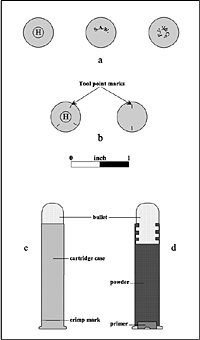
Components of a cartridge: a, examples of head
stamps; b, tool point marks; c, exterior and d,
interior of a .45-70 cartridge. Photo courtesy of
the Texas Historical Commission.
|
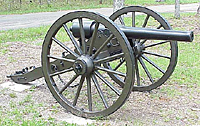
A 10-pounder Parrott Rifle.
|
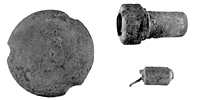
Shrapnel pieces from an exploded
Parrott shell, found by THC archeologists during survey.
Photo courtesy of the Texas Historical Commission.
|
|
Prior to the Indian Wars of the mid-1870s, the
preferred weapons of the U.S. Army were the Spencer repeating
carbine and .50 caliber, single shot Springfield rifle and
Sharps carbine. The Army selected the Springfield .45 caliber
rifle in 1873 as the weapon for the infantry and the shorter
carbine of the same caliber for the cavalry. These were the
arms primarily used by the Army during the Red River War.
Like the Springfield .50 caliber, the Springfield .45s were
single shot weapons that had to be reloaded after each fired
round. The best effective range for the Springfield .45 carbine
was less than 400 yards, but significant hits could be made
up to 600 yards. The bullet was driven out of the muzzle at
a velocity of about 1,200 feet per second, and it could travel
more than 1,000 yards
Archeological evidence gathered from the Red
River War battle sites indicates that the Indians were primarily
using repeating rifles such as the Spencer that fired a .50
caliber cartridge and could fire seven rounds before loading,
and the Winchester or Henry rifles that fired a .44 caliber
cartridge and could each hold up to 16 rounds of ammunition.
Most likely, the Indians acquired the Spencers, Winchesters,
and Henrys after the Civil War when large numbers of these
weapons became available to frontier traders and gunrunners.
With the Indians using repeating rifles and
the Army using single shot weapons, it might appear that the
Indians had the superior arms. In fact, many officers who
served the Union during the Civil War and were familiar with
the Spencer's firepower were very reluctant to exchange the
repeating Spencer for the new single shot Springfield .45.
So why did the Army change from the Spencer to the Springfield?
There appear to be two main reasons the Army made the change—one
financial and one tactical. After the Civil War, the Army
was forced to cut back on expenditures. The Army had recognized
that a soldier armed with a repeating rifle would expend a
large amount of ammunition during battle whether he had a
clear target in sight or not. The belief was that with a single
shot rifle, the soldier would become more efficient with his
ammunition and take only clear shots at his target.
Further, many officers had come to believe that
the single shot Springfield was a weapon superior to the Spencer.
The new .45 caliber Springfield cartridge had greater accuracy
and velocity at long ranges. Many of the Army officers who
had experienced warfare on the Plains realized they needed
those advantages in combating what could be characterized
as "guerilla warfare." Indians tended to stay at
a distance from the soldiers and to engage in close range
combat only when the enemy was clearly outnumbered or could
be surprised with a sudden attack. Therefore, even though
the Spencer, Winchester, and Henry repeating rifles could
fire more rounds in a shorter amount of time than the single-shot
Springfield, it appears the Springfield, with its longer range,
was the superior gun of the Indian Wars.
There were weapons other than rifles and carbines
that were used by the U.S. Army and the Indians during the
Red River War. The Indians, for example, also used the bow
and arrow. Metal arrowpoints that were either made by the
Indians or were acquired through trade were found at several
of the battle sites. Although bows and arrows may have played
a part in the battles, the long range at which most of the
fighting occurred during the battles did not allow the bow
and arrow a prominent role.
In 1874, the U.S. Army also used the Colt single
action Army revolver. This pistol fired six .45-caliber cartridges.
The effective range of the Colt revolver dropped off rapidly
over 60 yards. During the campaign, the Army employed various
kinds of artillery as well. Colonel Nelson A. Miles, for example,
had two Gatling guns that fired a .50 caliber bullet. The
Gatling gun was capable of firing up to 300 rounds per minute.
At the Battle of Red River on August 30, 1874, Col. Nelson
Miles used the Gatling against the Southern Cheyenne—the
first time the gun was used in combat west of the Mississippi
River. Miles also brought along a 10-pounder Parrott rifle,
which was actually a small cannon. The Parrott rifle fired
a shell that measured 8.8 inches long by 2.86 in diameter.
The shell exploded upon impact and the shell casing became
the shrapnel. The maximum range of the 10-pounder Parrott
rifle at five degrees elevation was about 2,000 yards.
Another piece of artillery that was used by
the Army during the Red River War was the mountain howitzer.
The howitzer was a short-barreled cannon designed to fire
projectiles with relatively small powder charges at short
ranges. The howitzer was capable of firing either the spherical
shell or the cylindrical canister.
|

A model 1866 Winchester rifle.
Click images to enlarge
|

A Henry model 1866 rifle.
|
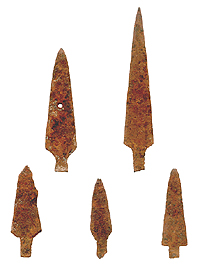
Metal arrow points used by the Southern
Plains Indians. Photo courtesy of the Texas Historical
Commission.
|
|
A shell for a 10-pounder Parrott
rifle.
|
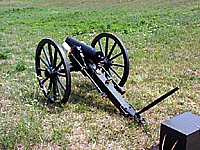
A mountain howitzer.
|
|